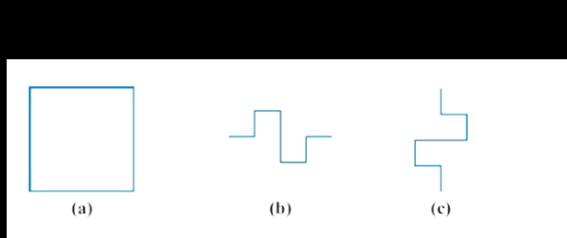
Exercises 13 through 16 refer to the construction of the quadratic Koch island. The quadratic Koch island is defined by the following recursive replacement rule.
Quadratic Koch Island
• Start: Start with a seed square [Fig. 12-37(a)]. (Notice that here we
are only dealing with the boundary of the square.)
• Replacement rule: In each step replace any horizontal boundary
segment with the “sawtooth” version shown in Fig. 12-37(b) and
any vertical line segment with the “sawtooth” version shown in Fig.
12-37(c)

This exercise is a continuation of Exercise 13.
a. Find the area of the figure obtained in Step
b. Find the area of the figure obtained in Step
c. Explain why the area of the quadratic Koch Island is the same as the area of the seed square.
13. Assume that the seed square of the quadratic Koch Island has sides of length
a. Carefully draw the figures obtained in Steps
b. Find the perimeter of the figure obtained in Step
c. Find the perimeter of the figure obtained in Step
d. Explain why the quadratic Koch island has infinite perimeter.
Want to see the full answer?
Check out a sample textbook solution
Chapter 12 Solutions
EBK EXCURSIONS IN MODERN MATHEMATICS
- For number 9 The answer is A Could you show me howarrow_forwardThe answer is B, Could you please show the steps to obtain the answerarrow_forward2. Suppose that U(x, y, z) = x² + y²+ z² represents the temperature of a 3-dimensional solid object at any point (x, y, z). Then F(x, y, z) = -KVU (x, y, z) represents the heat flow at (x, y, z) where K > 0 is called the conductivity constant and the negative sign indicates that the heat moves from higher temperature region into lower temperature region. Answer the following questions. (A) [90%] Compute the inward heat flux (i.e., the inward flux of F) across the surface z = 1 - x² - y². (B) [10%] Use the differential operator(s) to determine if the heat flow is rotational or irrotational.arrow_forward
- Could you show why the answer is B Using polar coordinates and the area formulaarrow_forward1. The parametric equations x = u, y = u cos v, z = usin v, with Ou≤ 2, 0 ≤ v ≤ 2π represent the cone that is obtained by revolving (about x-axis) the line y = x (for 0 ≤ x ≤2) in the xy-plane. Answer the following questions. (A) [50%] Sketch the cone and compute its surface area, which is given by dS = [ | Ər Or ди მა × du dv with S being the cone surface and D being the projection of S on the uv-plane. (B) [50%] Suppose that the density of the thin cone is σ(x, y, z) = 0.25x gr/cm². Compute the total mass of the cone.arrow_forwardThe value of sin (2V · F) at x = 3, y = 3, z = −4, where F -0.592 -0.724 0.661 -0.113 -0.822 -0.313 0.171 0.427 = (-2x² + -4,2yz − x − 3, −5xz - 2yz), isarrow_forward

 Glencoe Algebra 1, Student Edition, 9780079039897...AlgebraISBN:9780079039897Author:CarterPublisher:McGraw HillAlgebra & Trigonometry with Analytic GeometryAlgebraISBN:9781133382119Author:SwokowskiPublisher:Cengage
Glencoe Algebra 1, Student Edition, 9780079039897...AlgebraISBN:9780079039897Author:CarterPublisher:McGraw HillAlgebra & Trigonometry with Analytic GeometryAlgebraISBN:9781133382119Author:SwokowskiPublisher:Cengage Holt Mcdougal Larson Pre-algebra: Student Edition...AlgebraISBN:9780547587776Author:HOLT MCDOUGALPublisher:HOLT MCDOUGAL
Holt Mcdougal Larson Pre-algebra: Student Edition...AlgebraISBN:9780547587776Author:HOLT MCDOUGALPublisher:HOLT MCDOUGAL College Algebra (MindTap Course List)AlgebraISBN:9781305652231Author:R. David Gustafson, Jeff HughesPublisher:Cengage Learning
College Algebra (MindTap Course List)AlgebraISBN:9781305652231Author:R. David Gustafson, Jeff HughesPublisher:Cengage Learning




